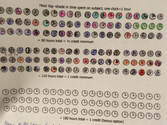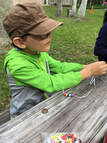|
Talking About
Florida Homeschooling... Evaluations and More |
A good evaluator works for the parents, assisting them in meeting legal requirements and in supporting them when districts overstep their bounds." |
 Figuring out how to grant high school credits seems daunting to some homeschool parents, but it’s not as difficult as many imagine. There are several different options for figuring out credits. Parents can mix-and-match them, using one method for one class and another method for another class. Or pick a favorite and stick with it. Method 1: Count hours. This is how public schools determine credits. One credit high school classes in Florida meet for a total of 135 hours though a Carnegie Unit (the definition of a credit) is 120 hours. The amount of time doesn’t generally vary by subject as public high school schedules aren’t made to handle that. Of course, some of that time is spent checking attendance, dealing with absences and other administrative tasks, dealing with disciplinary issues, going through fire, code red, and other drills, getting photos taken, going to assemblies, etc. So it’s not necessary to be overly zealous in counting those hours. I found for myself, that it helped to have a simple form to use to track hours. I typed something up with clock symbols and simply shaded in a clock for every hour (or half a clock for a half hour or a fourth of a clock for a quarter hour) spent on each subject. Once 60 hours were reached, a half credit could be assigned. When 120 hours were reached, a full credit could be assigned. Method 2: Finish most of a textbook. This method works if you are using curriculum designed for a one year (i.e., one credit) course or a half year (one semester or half credit) course. Notice that you don’t have to finish the entire curriculum. After all, schools almost never finish theirs and therefore can’t require that homeschoolers do. Finishing 2/3 to 3/4 of a textbook will be good enough based on what happens in schools. But be careful, some high school textbooks are designed to be used for more than one year. The biology text we used says in its teacher materials that it can be used for a two-year biology sequence and gives several suggestions as to how that could be done; so requiring a student to finish 2/3 of that book for a single credit would be excessive. Feel free to skip lessons that the student has mastered or to pick topics of interest–after all, high school teachers often make the curriculum work for their students (or used to when teachers were allowed to actually exercise their judgment in teaching). This method can also be used with a list of topics covered in a typical high school class. If you cover most of the topics in a scope and sequence for a yearlong high school course, consider it a one credit class. Method 3: Take a test. There are a number of tests that can be taken to show high school learning. Some of these might lead to college credit once a child is accepted into a college degree program. CLEP tests and AP exams are examples. If the student gets a passing score on such a test, that could be used as proof that the student has learned an equivalent of a high school credit in that subject. In fact, the latest list of course titles for public schools put out by the Florida Dept. of Education lists course codes for credit granted due to CLEP exams. This method can be very useful to a student with a lot of prior knowledge or informal learning in a subject area that wasn’t tracked for high school. Method 4: Use credit as assigned by another organization. Some students use programs such as Time4Learning, Acellus Power Homeschool, FLVS, or a local college's dual enrollment plan; their parents then grant credit as the program tells them it is earned. This is very straight-forward in most situations. If the student earns one high school credit for English language arts, then the parent gives the student one credit. If a student struggles with a program, a parent may decide to change the program which can complicate matters. For example, say a student used FLVS but dropped a course two-thirds of the way through the year and changed to another program; the parent could decide that the two-thirds of a year already done counts and then cover about a third of a year of another program to finish the year and grant a full credit. Dual Enrollment Florida high school (or even middle school) students can take courses at local colleges. Typically a three-semester-hour college course will count as a half-credit high school class, but some classes count double. For example, English Composition 1 taken at a local college is a one semester college course but it counts as a one year (one credit) high school course according to the Bright Futures list of course equivalents. Courses with a lot of writing or that specify a lab section tend to count double. Consult the latest list to see what the Bright Futures program approves to be sure there won’t be issues if your student applies for the scholarship to college. Here’s the list for the 2020-2021 school year. Homeschoolers can be creative with their courses. They can use a variety of block scheduling techniques such as a schedule that covers a single course before moving on to another or working on two or three courses at a time. Others might study a topic over more than one school year. Many top private schools adnd even a few public schools use innovative scheduling techniques. No matter how your homeschool program organizes classes, at least one of the above methods should work to track credit hours. Cheryl Trzasko–homeschool mom and evaluator since 2003 FLHomeschoolEvaluations.com
1 Comment
Your blog is very useful who wants to know about "
Reply
Your comment will be posted after it is approved.
Leave a Reply. |
Archives
April 2024
Categories
All
|

 RSS Feed
RSS Feed






